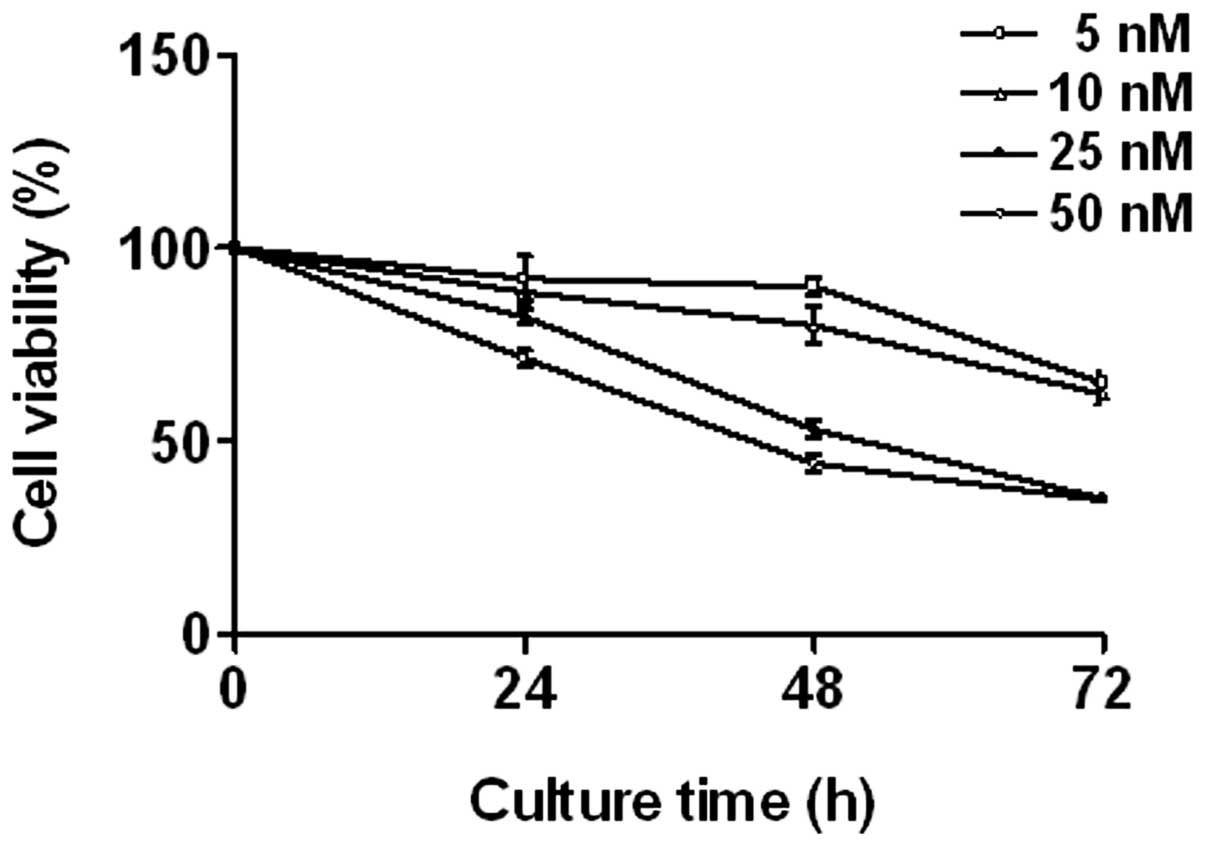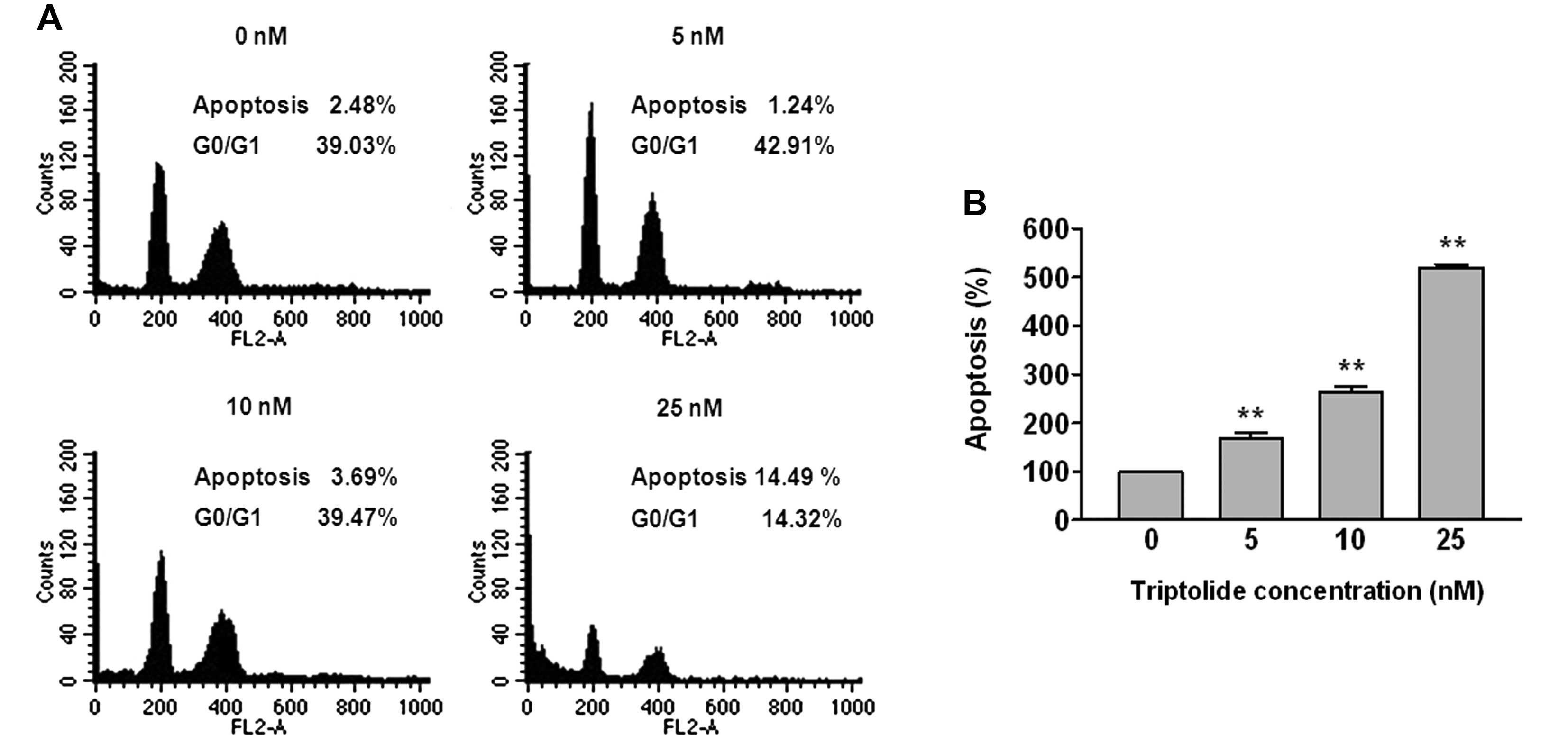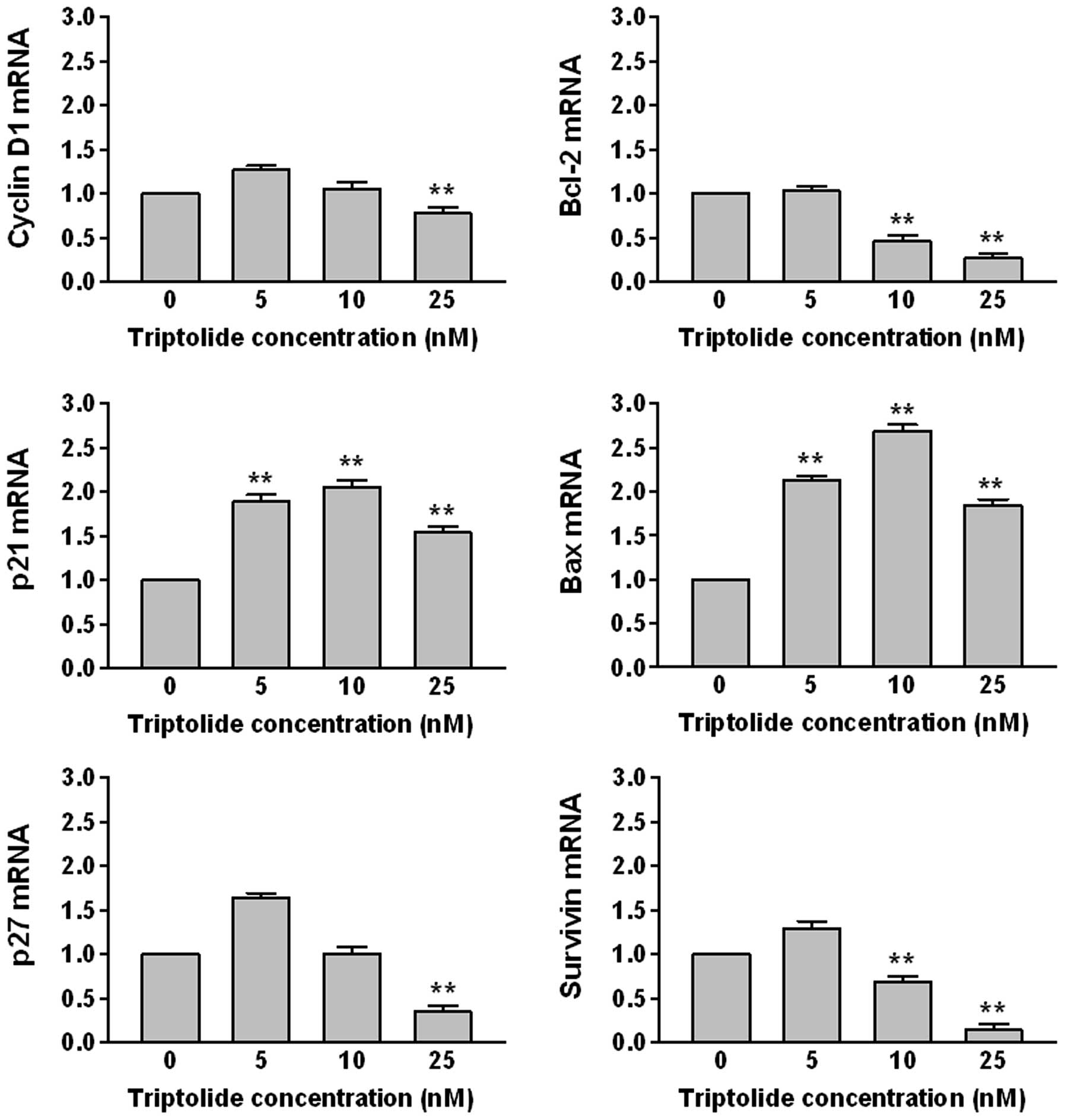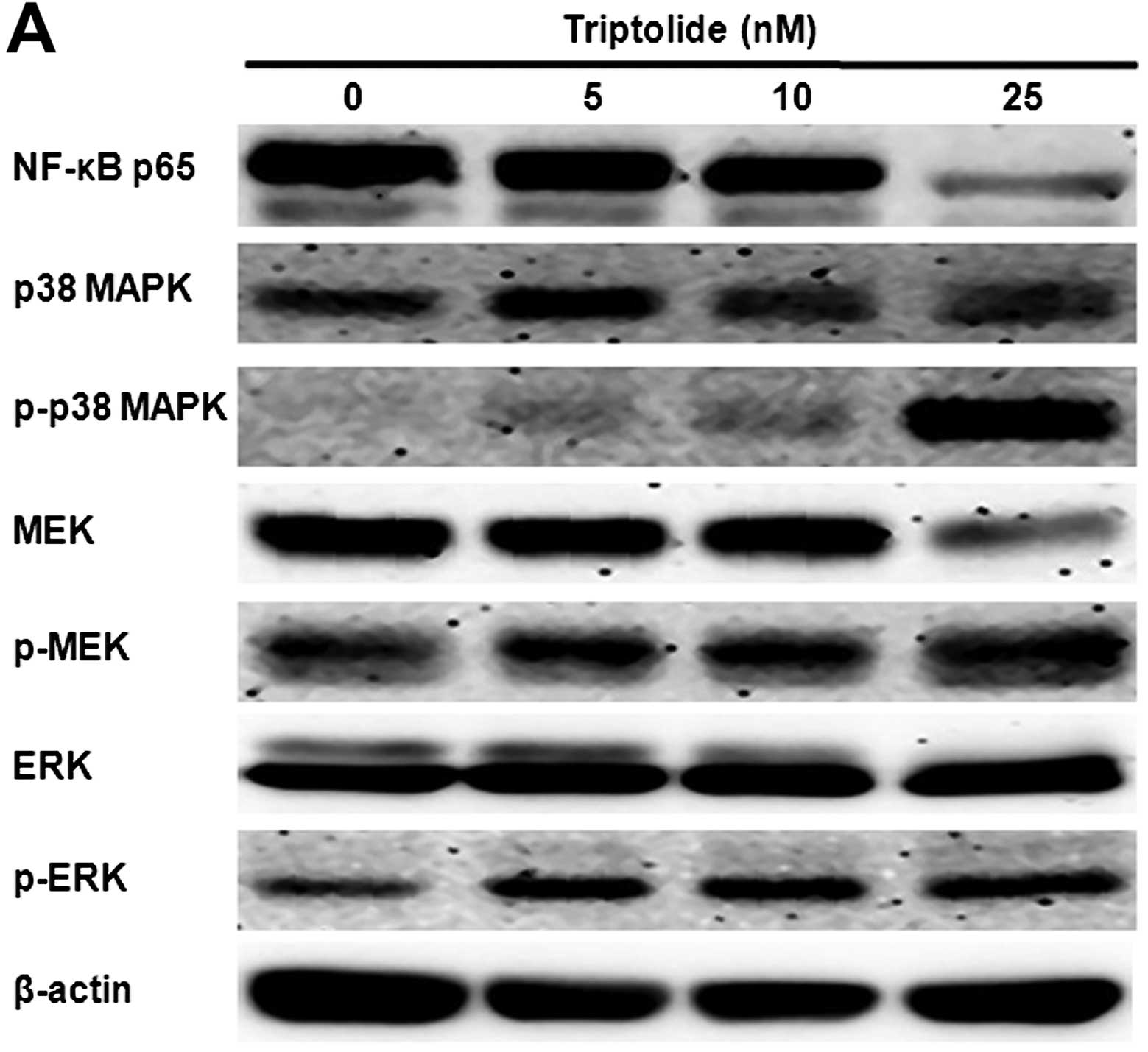Triptolide induces apoptosis of PMA-treated THP-1 cells through activation of caspases, inhibition of NF-κB and activation of MAPKs
- Authors:
- Published online on: July 23, 2013 https://doi.org/10.3892/ijo.2013.2033
- Pages: 1169-1175
Abstract
Introduction
Tripterygium wilfordii Hook F. has been used for centuries in traditional Chinese medicine to treat rheumatoid arthritis, an autoimmune disease associated with the increased production of the pro-inflammatory cytokine, tumor necrosis factor (TNF)-α. Triptolide, a compound originally purified from T. wilfordii Hook F., which has potent anti-inflammatory and immunosuppressant activities (1,2), has been reported to exert anti-neoplastic activity mainly by inducing apoptosis in various cancer cells (3–6). The exact mechanism responsible for the anti-neoplastic and anti-inflammatory effects of triptolide is not clearly understood.
Apoptosis is mediated through at least 3 major pathways, which are regulated by the death receptors, mitochondria and the endoplasmic reticulum. Activation of apoptosis pathways is a key mechanism by which cytotoxic drugs kill tumor cells and defects in apoptosis signaling contribute to tumor cell drug resistance (7,8). Among the important regulators of apoptosis are the members of the Bcl-2 family. This family of proteins includes both anti-apoptotic molecules, such as Bcl-2 and pro-apoptotic molecules, such as Bax (9). Triptolide induces apoptosis in T-cell hybridomas and peripheral T cells (10) and can sensitize TNF-α-resistant tumor cell lines to TNF-α-induced apoptosis (5).
Nuclear factor-κB (NF-κB) is active in most tumor types and regulates a series of pivotal events in the tumor progress, including cell survival, cell proliferation, angiogenesis and invasion (11). For cell survival, NF-κB mainly suppresses apoptosis by increasing the transcription of genes encoding anti-apoptotic proteins, for instance Bcl-2 and Bcl-XL(12). Thus, suppression of the NF-κB pathway should be effective in inducing apoptosis of tumor cells.
Moreover, mitogen-activated protein kinases (MAPKs) play a critical role in the regulation of cell growth and differentiation in the control of cellular responses to stress and cytokines. MAPK signaling pathways have also been shown to play critical roles in tumorigenesis. The activities of MAPKs are negatively regulated via dephosphorylation of certain conserved tyrosine and threonine residues by a family of MAPK phosphatases (MKPs) (13). Triptolide has been reported to suppress the expression of MKP-1, which inactivates extracellular signal-regulated kinase (ERK), p38 MAPK and c-Jun N-terminal kinase (JNK), to exert its anti-proliferative and pro-apoptotic activities (14).
In the present study, we used a human monocytic leukemia cell line, THP-1, which had been differentiated into macrophage-like cells by treatment with phorbol myristate acetate (PMA). We postulated that triptolide mediated its effects through multiple mechanisms, including activating cell cycle arrest and caspase-dependent pathways, as well as blocking NF-κB activation and potently activating the MAPK pathway.
Materials and methods
Cell culture
Human monocytic leukemia THP-1 cells were supplied by the Korean Cell Line Bank. Cells were cultured in RPMI-1640 medium (Gibco, Grand Island, NY, USA) containing 10% fetal bovine serum, 100 U/ml penicillin and 100 μg/ml streptomycin. Cells were incubated at 37°C in a humidified atmosphere of 5% CO2 in 95% air. THP-1 cells were treated with 100 nM of phorbol myristate acetate (PMA, Sigma-Aldrich Co., St, Louis, MO, USA) for 24 h to induce differentiation of the cells into macrophages. After differentiation, non-attached cells were removed by aspiration and the adherent macrophages were washed with RPMI-1640 medium 3 times and then incubated in cell culture medium at 37°C.
MTT assay
Cell proliferation was measured with CellTiter 96 Aqueous One Solution (Promega, Madison, WI, USA). Cells were seeded at 1×104 cells per well in 96-well plates and incubated with different concentrations of triptolide (Sigma-Aldrich) at 37°C for 24, 48 and 72 h. Cell viability was determined using a colorimetric assay with PMS/MTS solution. The absorbance was determined at 490 nm, with background subtraction at 650 nm.
Cell cycle analysis
Cells (5×105) were incubated with 5, 10 and 25 nM of triptolide for 48 h. After incubation, the cells were harvested and washed with PBS. Cells were fixed with 70% ethanol for 1 h, treated with RNase A (20 μg/ml) at 37°C for 1 h, before being stained with propidium iodide (50 μg/ml). DNA content at each cell cycle stage was analyzed using a FACSCalibur with CellQuest software (Becton-Dickinson, USA).
Apoptosis assay
For determining apoptosis in THP-1 cells, apoptotic cells were quantified using a cell death detection ELISAplus kit (Roche Molecular Biochemicals, Mannheim, Germany). Cells (1×104) were incubated with 5, 10 and 25 nM of triptolide for 48 h. Cells were lysed with cell lysis buffer (200 μl). Cell lysates were assayed for DNA fragments using the cell death ELISAplus kit according to the manufacturer’s protocol. DNA fragmentation was measured at 405 nm against an untreated control. To measure the enzymatic activity of caspase proteases, a caspase colorimetric assay kit (R&D Systems, Inc. Minneapolis, MN, USA) was used. THP-1 cells (2×106) were treated with 5, 10 and 25 nM of triptolide for 48 h. Cells were harvested and cell pellets were lysed in 50 μl of lysis buffer on ice for 10 min. The proteins concentration in the supernatant (cytosolic extract) was measured by BCA assay. The activities of caspase-3-, -8 and -9-like proteases were measured by proteolytic cleavage of substrates, including DEVD-pNA (caspase-3 substrate), IETD-pNA (caspase-8 substrate) and LEHD-pNA (caspase-9 substrate) respectively. These colorimetry substrates were solubilized in an assay buffer. After incubation with the substrates at 37°C for 1 h in the dark, color production in the lysates was measured with a microplate reader at 405 nm. Caspase-3, -8 and -9 activities were determined by direct comparison to the level of the uninduced control. To assess the effect of caspase inhibitor treatment, THP-1 cells (1×104 cells) were pretreated with a pan-caspase inhibitor, Z-VAD-FMK, or a caspase-3-specific inhibitor, Z-DEVD-FMK (R&D Systems), for 2 h, followed by addition of 50 nM triptolide. After 48 h, cell viability was determined by a colorimetric assay with PMS/MTS solution. The absorbance was determined at 492 nm with background subtraction at 650 nm.
Nuclear staining with Hoechst 33258
Cells (1×105) were treated with 5, 10 and 25 nM of triptolide for 48 h and then washed with ice-cold PBS. The cells were fixed with 4% paraformaldehyde for 10 min, permeabilized with 0.05% Triton X-100 for 5 min and stained with 50 ng/ml of Hoechst 33258 (Sigma-Aldrich). The nuclear areas were observed and photographed with a fluorescent microscope and calculated with an Olympus 13×51 fluorescence microscope equipped with a Nuance 2.1 Multispectral Imaging System (Cambridge Research & Instrumentation, Inc., MA, USA).
RNA extraction and real-time PCR procedures
Total RNA was purified from cultured cells using the RNA-Bee solution kit (Tel-test, Friendswood, TX, USA), following the manufacturer’s protocol. First-strand cDNA synthesis was then made using 1 μg of RNA using a reverse transcriptase system (Promega). Reverse transcription was primed using random hexamers. The primer sequences and product sizes were as follows: cyclin D1 forward 5′-CCGTCCATGCGGAAGATC-3′, reverse 5′-ATGGCCAGCGGGAAGAC-3′, 86 bp; p21 forward 5′-CAGACCAGCATGACAGATTTC-3′, reverse 5′-TTAGGGC TTCCTCTTGGAGA-3′, 66 bp; p27 forward 5′-CCGGCTAA CTCTGAGGACAC-3′, reverse 5′-AGAAGAATCGTCGGT TGCAG-3′, 120 bp; Bcl-2 forward 5′-GATTGATGGGATCGT TGCCTTA, reverse 5′-CCTTGGCATGAGATGCAGGA-3′, 200 bp; Bax forward 5′-GGATGCGTCCACCAAGAAG-3′, reverse 5′-GCCTTGAGCACCAGTTTGC-3′, 216 bp; survivin forward 5′-GGCCCAGTGTTTCTTCTGCTT-3′, reverse 5′-GCAACCGGACGAATGCTTT-3′, 91 bp; β-actin forward 5′-GCGAGAAGATGACCCAGATC-3′, reverse 5′-GGATAGC ACAGCCTGGATAG-3′, 77 bp. Real-time PCR was performed on a StepOneplus real-time PCR system (Applied Biosystems, Foster, CA, USA) with Power SYBR Green PCR Master Mix. PCRs were performed with 1 μl cDNA in 20-μl reaction mixtures that consisted of 10 μl Power SYBR Green PCR Master Mix, 2 μl primers and 7 μl PCR-grade water. The reactions were performed with a denaturation step at 95°C for 10 min, followed by 40 cycles each consisting of 95°C for 15 sec and 60°C for 1 min. The crossing point of target genes with β-actin was calculated using the formula 2−(target gene − β-actin) and the relative amounts were quantified.
Immunoblot analysis
Cells (2×106) were treated with 5, 10 and 25 nM of triptolide for 48 h. After treatment, cells were washed with cold PBS and lysed using lysis buffer [20 mM Tris-HCl (pH 7.5), 150 mM NaCl, 1 mM Na2EDTA, 1 mM EGTA, 1% Triton, 2.5 mM sodium pyrophosphate, 1 mM β-glycerophosphate, 1 mM Na3VO4, 1 μg/ml leupeptin] containing 1 mM PMSF. The protein concentration was determined by means of a BCA protein assay according to the manufacturer’s protocol. Thirty micrograms of protein was fractionated on 12% SDS-PAGE and transferred by electrophoresis onto a nitrocellulose membrane. The membranes were blocked with 5% non-fat dry milk for 1 h at room temperature and incubated with anti-NF-κB p65, anti-p38, anti-phosphop38, anti-MEK1/2, anti-phospho-MEK1/2, anti-ERK1, anti-phospho-ERK1/2 (Cell Signaling Technology, Danvers, MA, USA) and β-actin antibodies (Sigma-Aldrich) at a 1:1,000 dilution with Tris-buffered saline containing 0.05% Tween-20 (TBS-T) at 4°C for 18 h. After washing with TBS-T for 1 h, the membranes were treated with horseradish peroxidaseconjugated secondary antibody, diluted 1:2,500 with TBS-T, for 1 h at room temperature. After washing the membranes with TBS-T for 1 h, proteins were detected using an Enhanced Chemiluminescence kit (Santa Cruz Biotechnology, Inc., Santa Cruz, CA, USA). Protein expression levels were analyzed using a Chemiluminescence Imaging system (Davinch-Chemi™, Seoul, Korea).
Statistical analysis
Values are expressed as the mean ± SD. Student’s t-test was used to evaluate differences between the control samples and triptolide-treated samples. Inhibition of apoptosis was estimated by the differences between the triptolide-treated sample and samples treated with a combination of caspase inhibitor and triptolide. *P<0.05 and **P<0.01 were considered statistically significant.
Results
Triptolide inhibits cell proliferation in THP-1 cells
THP-1 cells were treated with various concentrations of triptolide (0–50 nM) for 24, 48 and 72 h. The effect of triptolide on cell proliferation was measured using an MTT assay. Triptolide induced a significant decrease in THP-1 cell proliferation in a dose- and time-dependent manner (Fig. 1).
Triptolide induces cell populations
THP-1 cells were treated with 5, 10 and 25 nM of triptolide for 48 h, after which flow cytometric analyses were performed (Fig. 2A). The apoptosis fraction increased by 2.48, 1.24, 3.69 and 14.49%, whereas the G0/G1 phase decreased by 39.03, 42.91, 39.47 and 14.32%, respectively, in THP-1 cells.
Triptolide induces apoptosis
THP-1 cells were treated with 5, 10 and 25 nM of triptolide for 48 h and apoptotic cells were quantified using a cell death detection ELISA (Fig. 2B). The number of apoptotic cells increased in a dose-dependent manner. Hoechst 33258 staining was used to observe the morphology of cell apoptosis. When THP-1 cells were exposed to triptolide for 48 h, apoptotic cells characterized by morphological alteration such as condensed nuclei and cell shrinkage were observed and the apoptotic cell number increased with the dose (Fig. 2C). Caspases are cysteine-aspartate proteases that play critical roles during the initiation and execution of apoptosis. To further elucidate the mechanism involved in the observed apoptosis, intracellular caspase-3, -8 and -9 activities were measured in THP-1 cells treated with various concentrations of triptolide (Fig. 2D), using a colorimetric ELISA. Caspase-3 and -9 activities were increased in response to triptolide treatment in a dose-dependent manner at 48 h. To confirm whether the activation of caspases is involved in triptolide-induced apoptosis, cell growth of THP-1 cells by triptolide was determined by MTT assay in the presence of the pan-caspase inhibitor Z-VAD-FMK and the caspase-3-specific inhibitor Z-DEVD-FMK. As shown in Fig. 2E, treatment with 25 nM triptolide resulted in an increase in proliferation of THP-1 cells after pretreatment with 10–50 μM Z-VAD-FMK as well as by 10–50 μM Z-DEVD-FMK.
Triptolide mediates gene expression
The level of mRNAs transcribed from cell cycle-related genes (cyclin D1, p21, p27) and apoptosis-related genes (Bcl-2, Bax, survivin) were examined by real-time PCR (Fig. 3). THP-1 cells were treated with 5, 10 and 25 nM of triptolide for 48 h. The levels of Bcl-2, cycline D1, p27 and survivin mRNA were decreased, whereas those of Bax and p21 mRNA were increased in a dose-dependent manner.
Triptolide inhibits NF-κB activation and enhances p38 MAPK and MEK/ERK phosphorylation
THP-1 cells were incubated with triptolide at 5, 10 and 25 nM for 48 h. After triptolide treatment, protein expression levels were measured by western blot analysis (Fig. 4). The levels of NF-κB p65 significantly declined after cells were exposed to triptolide. Triptolide induced a marked increase in the levels of phosphorylated p38 MAPK, MEK and ERK1/2.
Discussion
Triptolide is known to affect many cellular events, to have anti-neoplastic activity and induce apoptosis. Triptolide inhibits cell growth in variety of tumor cells (15,16). In this study, human monocytic leukemia THP-1 cells that had been PMA-differentiated showed inhibition of cell proliferation after triptolide treatment, in a dose-and time-dependent manner. To elucidate whether triptolide decreased cell viability by inducing apoptosis, we investigated its effect on the expression of apoptosis-related factors and found that triptolide increased the apoptosis fraction at cell cycle and the number of apoptotic THP-1 cells in a dose-dependent manner. These results suggested that triptolide not only inhibits THP-1 cell growth and blocks cell cycle progression at the G1 phase, but also induces apoptosis. Triptolide has also been reported to induce significant apoptosis and minor accumulation in the S phase in THP-1 cells (17). However, treatment with triptolide was shown to reduce the viability of HeLa and Caski cells in a concentration-dependent manner and to increase accumulation of sub-G1 phase cells and apoptotic bodies (16).
Triptolide not only regulates cell growth, but also induces programmed cell death in several types of cells. It appears that triptolide induces apoptosis by activating caspases, the proteases responsible for cell death in multiple myeloma cells and leukemic cells (18,19). Caspases play important roles in the apoptotic process (20,21). When investigating the molecular mechanism underlying apoptosis of THP-1 cells in response to triptolide, we found that treatment of THP-1 cells with triptolide produced increases in intracellular caspase-3 activity. This finding was confirmed by experiments using the pancaspase inhibitor Z-VAD-FMK and the caspase-3-specific inhibitor Z-DEVD-FMK, which enhanced cell growth in triptolide-treated cells. These results suggest that the apoptotic effect of triptolide in THP-1 cells may result from the regulation of the caspase pathways. Caspase-3 and -9 activity play important roles in apoptosis through a mitochondria-dependent pathway. It has been shown that the induction of apoptosis in cervical cancer cells by triptolide is associated with activation of caspases (16). Moreover, it was reported that triptolide may induce apoptosis through a mitochondria-mediated apoptotic pathway in a caspase-dependent way in human melanoma A375 cells (22).
Bcl-2 gene-family members have been widely considered to be regulators of cell death (23). In this study, our results revealed that triptolide treatment of THP-1 cells upregulated the mRNA expression of genes encoding Bax and p21 and downregulated those encoding Bcl-2, cycline D1, p27 and survivin. These results suggested that triptolide regulated transcription factors of cell cycle-related genes and apoptosis-related genes. It has previously been shown that triptolide treatment leads to increased Bax expression and decreased Bcl-2 expression (24). In contrast, Bax expression was significantly up-regulated in SW1990 cells treated with triptolide, while Bcl-2 mRNA was not (25).
Triptolide has also been shown to decrease anti-apoptotic mechanisms through NF-κB inhibition (26,27). We investigated whether this regulatory mechanism is also involved in the process of apoptosis in THP-1 cells; our results indicated that triptolide suppressed NF-κB activation, suggesting that triptolide induced apoptosis through inhibition of NF-κB activation. Recent reports demonstrated that the NF-κB signal is clearly downregulated during apoptosis induced by triptolide (15). Bcl-2 and Bcl-XL are members of the Bcl-2 family whose expression is regulated by NF-κB. Triptolide induces apoptosis by means of inhibiting NF-κB through downregulating the expression of the genes encoding Bcl-2 and Bcl-XL(22). Our study supports that the NF-κB pathways are involved in the process of THP-1 cell apoptosis induced by triptolide.
The MAPK pathway is a key signaling mechanism that regulates many cellular functions, such as cell growth, transformation and apoptosis (28). MAPKs can mediate apoptotic signaling induced by antineoplastic agents (29). ERK, JNK and p38 MAPK constitute 3 major subfamilies of MAPKs that appear to mediate cellular responses, including proliferation, differentiation and apoptosis (30). Gleditsia sinensis thorns (WEGS) induced phosphorylation of ERK1/2, p38 MAPK and JNK in human colon cancer cells (31). Danshensu increased phosphorylation of Akt and ERK1/2 in H9c2 cardiomyocytes (32). Induction of cell death can be mediated by activating ERK1/2 (33,34). We found that triptolide enhanced the level of p38 MAPK and MEK/ERK phosphorylation in THP-1 cells. These results suggest that triptolide mediates cell growth and apoptosis through the activation of the MEK/ERK pathway.
In conclusion, we demonstrated that triptolide inhibits the growth of THP-1 cells by inducing apoptosis through the activation of caspases, as well as inhibiting NF-κB and activating MAPK pathways. However, studies are needed to explore further details of the mechanisms underlying the effect of triptolide on human monocytic leukemia cells.
Acknowledgements
This study was supported by Bio-industry Technology Development Program, Ministry for Food, Agriculture, Forestry and Fisheries, Republic of Korea (grant no. 311059-4) and partially supported by the Rural Development Administration, Republic of Korea (grant no. PJ008475022012). We thank Waterborne Virus Bank for the technical support of real-time PCR work.
References
|
Chen BJ: Triptolide, a novel immunosuppressive and anti-inflammatory agent purified from a Chinese herb Tripterygium wilfordii Hook F. Leuk Lymphoma. 42:253–265. 2001. View Article : Google Scholar : PubMed/NCBI | |
|
Qiu D and Kao PN: Immunosuppressive and anti-inflammatory mechanisms of triptolide, the principal active diterpenoid from the Chinese medicinal herb Tripterygium wilfordii Hook. f. Drugs R D. 4:1–18. 2003. View Article : Google Scholar : PubMed/NCBI | |
|
Shamon LA, Pezzuto JM, Graves JM, et al: Evaluation of the mutagenic, cytotoxic and antitumor potential of triptolide, a highly oxygenated diterpene isolated from Tripterygium wilfordii. Cancer Lett. 112:113–117. 1997. View Article : Google Scholar : PubMed/NCBI | |
|
Tengchaisri T, Chawengkirttikul R, Rachaphaew N, Reutrakul V, Sangsuwan R and Sirisinha S: Antitumor activity of triptolide against cholangiocarcinoma growth in vitro and in hamsters. Cancer Lett. 133:169–175. 1998. View Article : Google Scholar : PubMed/NCBI | |
|
Lee KY, Chang W, Qiu D, Kao PN and Rosen GD: PG490 (triptolide) cooperates with tumor necrosis factor-α to induce apoptosis in tumor cells. J Biol Chem. 274:13451–13455. 1999.PubMed/NCBI | |
|
Chan EW, Cheng SC, Sin FW and Xie Y: Triptolide induced cytotoxic effects on human promyelocytic leukemia, T cell lymphoma and human hepatocellular carcinoma cell lines. Toxicol Lett. 122:81–87. 2001. View Article : Google Scholar : PubMed/NCBI | |
|
Tsuruo T, Naito M, Tomida A, et al: Molecular targeting therapy of cancer: drug resistance, apoptosis and survival signal. Cancer Sci. 94:15–21. 2003. View Article : Google Scholar : PubMed/NCBI | |
|
Debatin KM: Apoptosis pathways in cancer and cancer therapy. Cancer Immunol Immunother. 53:153–159. 2004. View Article : Google Scholar : PubMed/NCBI | |
|
Levine B, Sinha S and Kroemer G: Bcl-2 family members: dual regulators of apoptosis and autophagy. Autophagy. 4:600–606. 2008. View Article : Google Scholar : PubMed/NCBI | |
|
Yang Y, Liu Z, Tolosa E, Yang J and Li L: Triptolide induces apoptotic death of T lymphocyte. Immunopharmacology. 40:139–149. 1998. View Article : Google Scholar : PubMed/NCBI | |
|
Aggarwal BB: Nuclear factor-κB: the enemy within. Cancer Cell. 6:203–208. 2004. | |
|
Karin M: Nuclear factor-κB in cancer development and progression. Nature. 441:431–436. 2006. | |
|
Keyse SM: Protein phosphatases and the regulation of mitogen-activated protein kinase signaling. Curr Opin Cell Biol. 12:186–192. 2000. View Article : Google Scholar : PubMed/NCBI | |
|
Liu Q: Triptolide and its expanding multiple pharmacological functions. Int Immunopharmacol. 11:377–383. 2011. View Article : Google Scholar : PubMed/NCBI | |
|
Zhu W, Hu H, Qiu P and Yan G: Triptolide induces apoptosis in human anaplastic thyroid carcinoma cells by a p53-independent but NF-κB-related mechanism. Oncol Rep. 22:1397–1401. 2009.PubMed/NCBI | |
|
Kim MJ, Lee TH, Kim SH, Choi YJ, Heo J and Kim YH: Triptolide inactivates Akt and induces caspase-dependent death in cervical cancer cells via the mitochondrial pathway. Int J Oncol. 37:1177–1185. 2010.PubMed/NCBI | |
|
Pigneux A, Mahon FX, Uhalde M, et al: Triptolide cooperates with chemotherapy to induce apoptosis in acute myeloid leukemia cells. Exp Hematol. 36:1648–1659. 2008. View Article : Google Scholar : PubMed/NCBI | |
|
Yinjun L, Jie J and Yungui W: Triptolide inhibits transcription factor NF-kappaB and induces apoptosis of multiple myeloma cells. Leuk Res. 29:99–105. 2005. View Article : Google Scholar : PubMed/NCBI | |
|
Carter BZ, Mak DH, Schober WD, et al: Triptolide induces caspase-dependent cell death mediated via the mitochondrial pathway in leukemic cells. Blood. 108:630–637. 2006. View Article : Google Scholar : PubMed/NCBI | |
|
Kim R, Emi M and Tanabe K: Caspase-dependent and -independent cell death pathways after DNA damage (Review). Oncol Rep. 14:595–599. 2005.PubMed/NCBI | |
|
Denault JB and Salvesen GS: Caspases: keys in the ignition of cell death. Chem Rev. 102:4489–4500. 2002. View Article : Google Scholar : PubMed/NCBI | |
|
Tao Y, Zhang ML, Ma PC, et al: Triptolide inhibits proliferation and induces apoptosis of human melanoma A375 cells. Asian Pac J Cancer Prev. 13:1611–1615. 2012. View Article : Google Scholar : PubMed/NCBI | |
|
Chao DT and Korsmeyer SJ: BCL-2 family: regulators of cell death. Annu Rev Immunol. 16:395–419. 1998. View Article : Google Scholar | |
|
Li J, Zhu W, Leng T, et al: Triptolide-induced cell cycle arrest and apoptosis in human renal cell carcinoma cells. Oncol Rep. 25:979–987. 2011.PubMed/NCBI | |
|
Zhou GX, Ding XL, Huang JF, et al: Apoptosis of human pancreatic cancer cells induced by Triptolide. World J Gastroenterol. 14:1504–1509. 2008. View Article : Google Scholar : PubMed/NCBI | |
|
Lee KY, Park JS, Jee YK and Rosen GD: Triptolide sensitizes lung cancer cells to TNF-related apoptosis-inducing ligand (TRAIL)-induced apoptosis by inhibition of NF-κB activation. Exp Mol Med. 34:462–468. 2002.PubMed/NCBI | |
|
Frese S, Pirnia F, Miescher D, et al: PG490-mediated sensitization of lung cancer cells to Apo2L/TRAIL-induced apoptosis requires activation of ERK2. Oncogene. 22:5427–5435. 2003. View Article : Google Scholar : PubMed/NCBI | |
|
Rubinfeld H and Seger R: The ERK cascade: a prototype of MAPK signaling. Mol Biotechnol. 31:151–174. 2005. View Article : Google Scholar : PubMed/NCBI | |
|
Fan M and Chambers TC: Role of mitogen-activated protein kinases in the response of tumor cells to chemotherapy. Drug Resist Updat. 4:253–267. 2001. View Article : Google Scholar : PubMed/NCBI | |
|
Davis RJ: The mitogen-activated protein kinase signal transduction pathway. J Biol Chem. 268:14553–14556. 1993.PubMed/NCBI | |
|
Lee SJ, Park K, Ha SD, Kim WJ and Moon SK: Gleditsia sinensis thorn extract inhibits human colon cancer cells: the role of ERK1/2, G2/M-phase cell cycle arrest and p53 expression. Phytother Res. 24:1870–1876. 2010. View Article : Google Scholar : PubMed/NCBI | |
|
Yin Y, Guan Y, Duan J, et al: Cardioprotective effect of Danshensu against myocardial ischemia/reperfusion injury and inhibits apoptosis of H9c2 cardiomyocytes via Akt and ERK1/2 phosphorylation. Eur J Pharmacol. 699:219–226. 2013. View Article : Google Scholar : PubMed/NCBI | |
|
Stanciu M, Wang Y, Kentor R, et al: Persistent activation of ERK contributes to glutamate-induced oxidative toxicity in a neuronal cell line and primary cortical neuron cultures. J Biol Chem. 275:12200–12206. 2000. View Article : Google Scholar : PubMed/NCBI | |
|
Wang X, Martindale JL and Holbrook NJ: Requirement for ERK activation in cisplatin-induced apoptosis. J Biol Chem. 275:39435–39443. 2000. View Article : Google Scholar |













